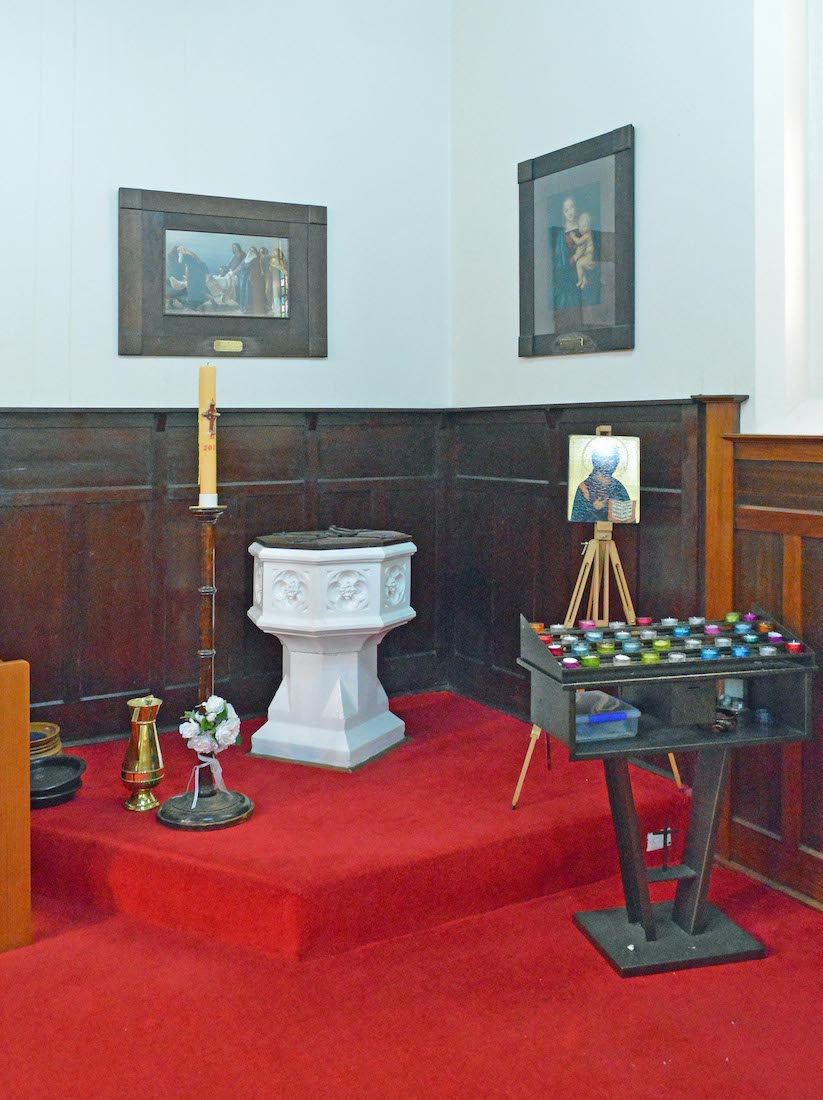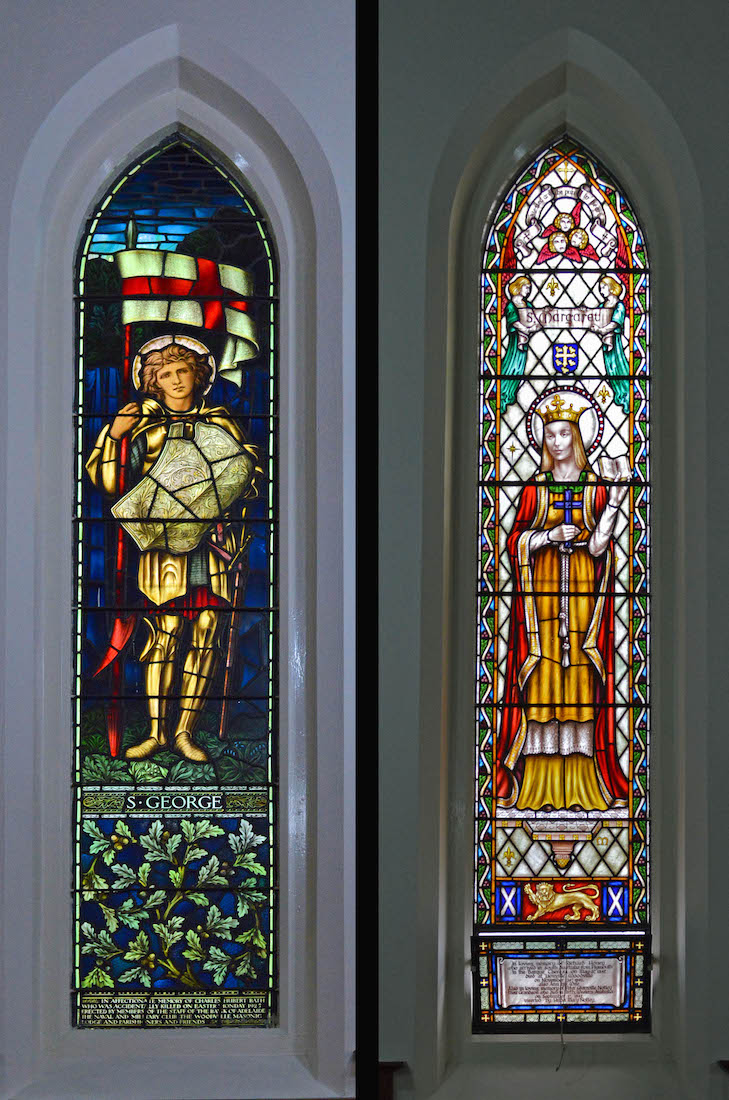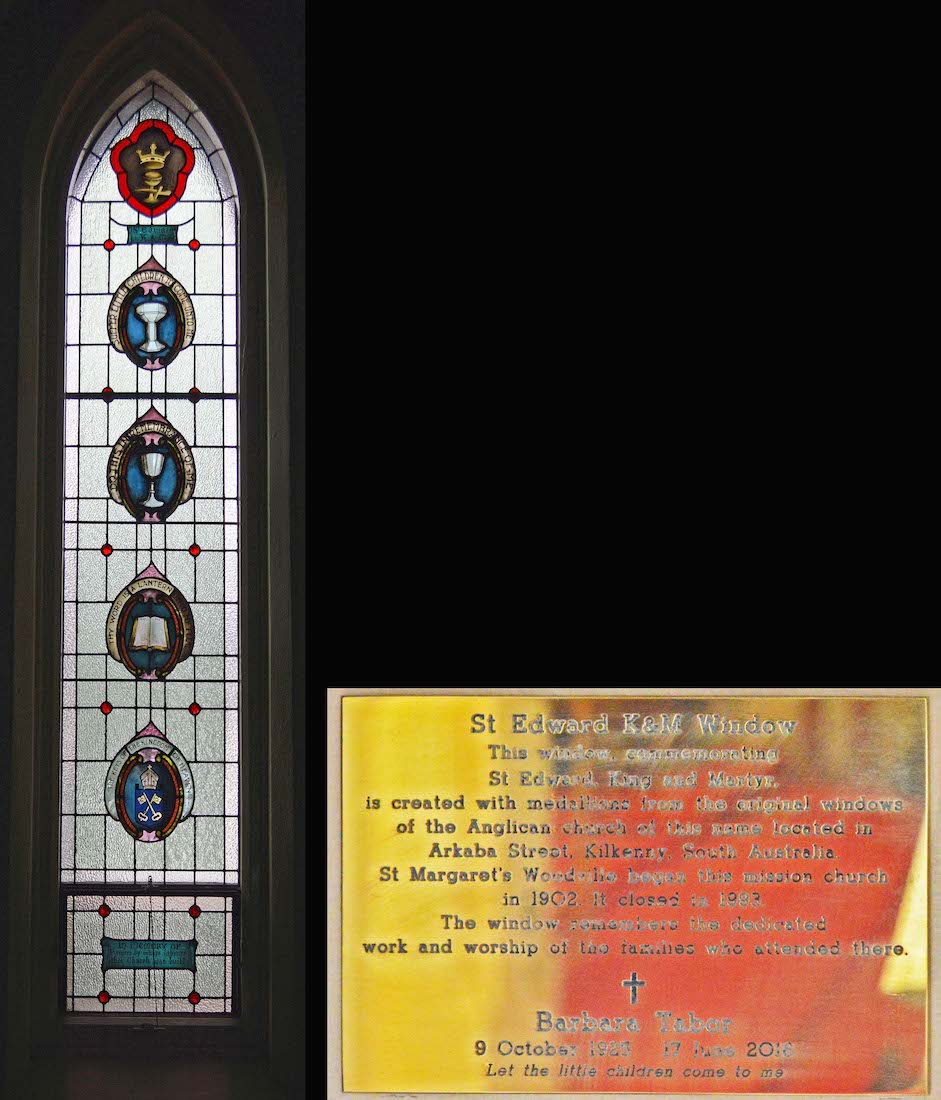
There are a number of items for us to explore at the back of the nave. We observe at left a painting, a banner, and a framed display of some sort. At right are two prints in large dark wooden frames – often found in older South Australian churches. Below we can see a baptismal font, and to the right, an icon of Christ with a votive candle stand. We now look more closely at these items. INDEX
22. BANNER

Closer inspection of the banner shows that is is a colourful collage of squares depicting religious icons, items from the Church, and references to families worshipping here in 1996. It makes a grand display!
23. PAINTING
The painting shows Jesus with a group of small children. There is a text: ‘Suffer little children to come unto me.‘ The painting was given in remembrance of Alice van Sanden. The original painting was by English artist Margaret W. Tarrant who lived 1888 – 1959. At right is a handworked image of the Church, and below, an array giving the names of the families involved in creating the 140th Anniversary Commemorative Collage.
24. MEMORIAL ROSE GARDEN BOOK
Just by the door is a cabinet containing the Memorial Rose Garden Book, containing the names and dates of those with memorial plates in the garden. The display cabinet was presented in memory of parishioner and Church warden, Howard Simon.
25. BAPTISTRY CORNER
This gives a closer view of the items in this corner of the nave, and we can now see clearly the Paschal candle, and the brass ewer.
26. CHRIST ICON
Closer inspection reveals that this is not an actual painted icon of Christ but rather a reproduction. The same reproduction occurs on the cover of the book ‘Meeting Jesus today’ by Jeanie Miley, but I cannot trace it back further. It is interesting that iconography is experiencing a renewal here in Australia.
27. EWER AND FONT
The handsome brass ewer for pouring water into the font is a reminder of olden days before modern plumbing! The font appears to be one of a batch of mass produced fonts which were commonly manufactured in the early 20th century.
28. CHRIST BORNE TO THE TOMB
The original painting by Ciseri, the celebrated Italian artist, hangs in the Gallery at Locarno. It shows the removal of the crucified body of Jesus from Golgotha hill. (Matthew 27: 55-61) From left to right we see: Joseph of Arimathea, Nicodemus, Jesus, John, Mary the mother of Jesus, Mary Magdalene (with her face in her hands), Mary the mother of James and Joseph(?) and the wife of Zebedee(?). This was a gift in memory of Private Arthur C. Clutterbuck who died of wounds in 1917.
29. MADONNA AND CHILD
This is a print of ‘The Madonna del Granduca’ – a Madonna painting by the Italian renaissance artist Raphael. It was probably painted in 1505, shortly after Raphael had arrived in Florence. The influence of Leonardo da Vinci, whose works he got to know there, can be seen in the use of sfumato (hazy borders). The painting belonged to Ferdinand III, Grand Duke of Tuscany, from whom it got its name. It now hangs in Exeter Cathedral. This print was given in loving memory of Meliora Jane Ireland who died in 1920.
31. NORTH NAVE WINDOWS
From left: • ‘The Risen Christ’, given in memory of William Charlton and Maria Teare Harrison; • ‘The Good Shepherd’ given in memory of Ann Aquila Cowling, John and Roy Hamilton and Alice Russell; • ‘The Crucifixion’, given by the local branch of the Girls’ Friendly Society in memory of Margaret Harriette Stewart Blackburn; • ‘St Cecilia’ given in memory of Beatrice Alice Masson; • ‘Jesus and Peter’, given in memory of Henry William Connor.
32. SOUTH NAVE WALL
We next turn our attention to the South nave wall. Here there are just two stained glass windows.
33. SOUTH NAVE WINDOWS
From left we have: • ‘St George’, given in memory of Charles Hubert Bath; • ‘St Margaret’, given in memory of Richard Honey.
34. TOWARDS ST EDWARD’S CHAPEL
Standing just in front of the nave altar and looking South we observe St Edward’s Chapel. Edward the Martyr lived from c. 962 to 978, and was King of England from 975 until he was murdered in 978. In the foreground is an eagle lectern, and to the right a side altar. To the left, in fact by the organ pipes, is a list of parishioners who gave their lives in WWII. The board was erected by the families of the men who died, and dedicated by Canon E. C. Loan in 1956.
35. SIDE ALTAR
The picture on the side altar is of St Margaret, standing by a small child. The altar was given in memory of Howard Brittain Pash who died in 1937.
36. ST EDWARD’S CHAPEL
The left hand wall of the chapel is wood panelling which screens the organ pipes. At upper left is a brass plaque which we will look at shortly. The dark timber on the right side belongs to the exit doors from the chapel. Ahead is a set of drawers which serves as the chapel altar, and bears a cross and two candlesticks. Above is a single lancet stained glass window, and on the wall to the right, an enamelled cross. Closer to us on the left is a simple font, ewer, and two candlesticks.
37. BRASS PLAQUE AND FONT
The brass plaque tells us that this organ was erected by the parishioners as a memorial of the Jubilee of this Church (1855 – 1905), and in memory of Margaret H. S. Blackburn, wife of the Rector. The font with ewer is a simple affair, useful for small baptismal ceremonies where the intimacy of the chapel is preferred.
38. ALTAR AND DECORATED CROSS
The brass altar cross is of simple design, and the pair of matching brass candlesticks are attractive. The more ornate enamel cross on the wall at right is one of a pair, the other hanging in the sanctuary. Although they look rare, such crosses are easily available and are known as ‘Life of Christ’ wall crosses. On each cross, various scenes from the life of Christ are depicted in brilliant colour.
39. CHAPEL WINDOW
The chapel window consists of a column of crests set into an essentially plain window. From the top we have: • crown, chalice and sword, and beneath, the inscription ‘St Edward K & M’ (King and Martyr); a font with surrounding text, ‘Suffer the children to come unto me’; • a chalice with text, ‘Do this in remembrance of me’; • a Holy Bible with text, ‘Thy word is a lantern unto my feet’; • a mitre and crossed keys with text, ‘The keys of the Kingdom of Heaven’. Below is a text: ‘In memory of pioneers by whose labours this Church was built’. The adjacent plaque tells the history of the window.
40. LECTERN
Most Anglican churches have an eagle lectern. There are allusions here to Isaiah 40:31 – soaring with wings as eagles, and the traditional symbol of the eagle for John the Evangelist. This particular eagle has more character than many ... .


















